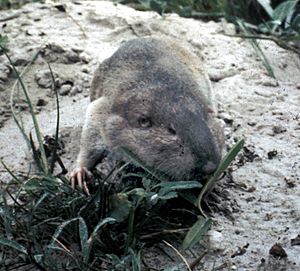Texas pocket gopher facts for kids
Quick facts for kids Texas pocket gopher |
|
|---|---|
 |
|
| Conservation status | |
| Scientific classification | |
| Genus: |
Geomys
|
| Species: |
personatus
|
The Texas pocket gopher (Geomys personatus) is a small rodent that lives underground. It belongs to a group of animals called pocket gophers. You can find this gopher in parts of Texas in the United States and Tamaulipas in Mexico.
Contents
About the Texas Pocket Gopher
What They Look Like
Male Texas pocket gophers can grow to be about 32 centimeters (13 inches) long. This includes their tail, which is about 11 centimeters (4 inches) long. Female gophers are a little smaller than the males. Both male and female gophers weigh around 400 grams (about 14 ounces).
Their fur is a dull grayish-brown color on their back. Their belly is whitish, but it might have some darker spots. Their tail has very little hair, especially near the end. These gophers have two grooves on their upper front teeth.
Where They Live
The Texas pocket gopher lives in southern Texas. You can find them as far north as Val Verde County and San Patricio County. They also live in the state of Tamaulipas, which is in northeastern Mexico.
These gophers are very common in the sandy areas. You can often find them on Mustang and Padre islands. These islands are located in the Gulf of Mexico. They need loose, sandy soil to dig their homes.
Life Underground
Their Burrows
Each Texas pocket gopher lives alone in its own burrow system. This underground home can have passages up to 30 meters (about 100 feet) long. It also has short side tunnels. The gopher protects its burrow from other animals. If an intruder comes close, it might make a wheezy sound or grind its teeth.
These gophers mostly stay underground. They block the entrances to their burrows with soil. When they dig, they push out piles of dirt. These dirt piles can be about 50 centimeters (20 inches) wide and 12 centimeters (5 inches) high.
What They Eat
Texas pocket gophers mainly eat the roots of grasses. Some of these grasses include paspalum (Paspalum), Bermuda grass (Cynodon), and sandbur (Cenchrus). They also eat all parts of sunflower plants (Helianthus).
They are very careful to avoid going above ground. This is because predators like owls or snakes could catch them. Instead, they grab the roots of plants and pull them down into their burrow to eat. They also eat some of their own waste. They pick up small pellets with their teeth. They then use their front paws to look at them carefully. They eat some of these pellets but not all of them. Scientists are not sure why they choose some and not others.
Reproduction and Young
Scientists do not know much about how Texas pocket gophers have babies. However, it seems they can have young at any time of the year. A mother gopher can have between one and five babies in one litter. It is thought that they might have up to two litters of young each year.
Conservation Status
The Texas pocket gopher lives in a large area. It is common in some parts of its home range. However, it is not found everywhere because it needs loose, sandy soil to dig its burrows.
The IUCN is a group that checks on animals around the world. They say the Texas pocket gopher is of "least concern". This means they are not worried about this gopher becoming endangered soon. Even though we don't know if their numbers are going up or down, they are not decreasing fast enough to be in a more threatened group.


